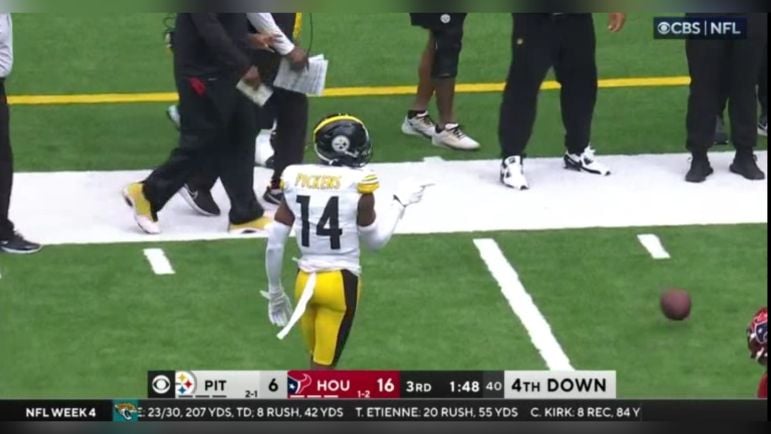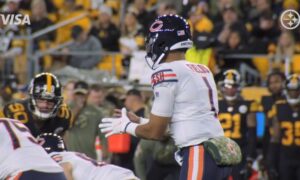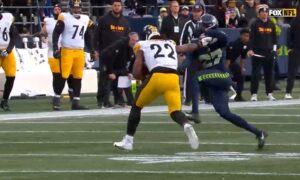Following each game in the 2023 Pittsburgh Steelers season, I will highlight the event or string of events in the game that is the turning point. Not all turning points will be earth-shattering but are meant to give a unique look at how we arrived at the outcome of the game, one that may be hard to see during the live watch.
Football, more than most games, hinges on every team member executing their role perfectly. The Pittsburgh Steelers’ game against the Houston Texans was a glaring reminder that football, at its core, hinges on precise teamwork. We’re talking about 11 guys on the field, each playing their part to perfection.
In layman’s terms? Execution.
Now, before we get lost in the 30-6 blowout in Houston, let’s dissect the back-to-back Steelers’ drives that spiraled the game into a disaster.
Staring at a 16-3 deficit midway through the third quarter, the Steelers had a glimmer of hope to bounce back into the game, thanks to one of the season’s most entertaining offensive plays. It was a backyard scramble drill as Kenny Pickett connected with Najee Harris, who rumbled down inside the 10-yard line.
Then, that all-too-familiar issue we’ve seen from the Steelers this year reared its ugly head: their tendency to falter in execution.
On a critical 3rd-and-goal, Offensive Coordinator Matt Canada dialed up his trips-bunch formation, a formation I’ve raved about all season. And for a good reason — it forces defensive backs into rapid communication and synchronized decision-making, with receivers jetting off in every possible direction post snap.
The play worked to perfection, drawing two defensive backs to one receiver, which left Connor Heyward (No. 83) chilling by himself in the back of the end zone. But, alas, Pickett’s eyes were glued to Allen Robinson II (No. 11). Mix in a dash of defensive pressure, and the result was a missed opportunity to connect with a wide-open Heyward for a crucial touchdown.
After that missed opportunity, Head Coach Mike Tomlin played it safe, opting for the field goal to trim the lead to 10 instead of going for the touchdown. A decision some might argue warrants its own deep dive and discussion.
Skip ahead to the Steelers’ subsequent drive, coming right after their defense sent the Texans’ offense back to the sidelines in a quick four plays. The tide seemed to be turning Pittsburgh’s way.
The offense picked up on this vibe, quickly nabbing two first downs in a trio of plays.
Imagine the scenario: Steelers cap this drive with their first touchdown, putting them just a field goal behind with a whole quarter left to play. Houston’s confidence starts to waver, sensing the game might just be slipping away.
But alas, our old nemesis – the execution gremlin – showed up to rain on the Steelers’ parade.
On the first down, Texans safety Jalen Pitre showcased some serious homework. He picked up on Robinson’s motion into the “sniffer” position, beat Robinson to his intended spot, and then flat-out bulldozed RB Jaylen Warren just as he was receiving the handoff.
The ball pops out, and, in a stroke of luck, Pickett’s right there to cover it up. Nothing like a loss of eight on the first down to kill a once-promising drive.
Facing a daunting 3rd and 18, the offense manages to claw back most of those yards. Now, here’s where things get interesting. George Pickens, after snagging the ball, decides to cut back across the cornerback instead of just gunning it straight ahead.
That little detour? It cost Pickens his forward momentum, stopping him short of the line to gain. It’s those tiny, often overlooked moments that snowball into the larger, talk-of-the-town plays, like the divisive fourth-down decision that had everyone buzzing.
It is this week’s turning point of the game.
Whether you’re a fan of the play call or not, the truth is, execution is king.
Is it ideal to go shotgun pass on fourth and one without play-action? No.
But here’s the tea: coaches do their part by making the calls, but it’s up to the players to bring them to life on the field. Imagine if Canada had gone with a classic run up the middle and it flopped. The narrative would’ve quickly turned to the lack of creativity. But, get a solid push from the offensive line, and suddenly, it’s a different story.
Canada goes back to his trips bunch set that we saw earlier on the last drive. It gets Heyward open again. This time on an option route.
But when it came to nailing the execution? Swing and a miss, yet again.
If Pickett fires this into Heyward’s chest, 99 times out of 100, he’s catching this ball.
But let’s play devil’s advocate. Say the throw to Heyward doesn’t look as picture-perfect to Pickett.
With a quick sidestep to his left and eyes still scanning the field, Pickett still has a trio of options:
- Heyward extending his route running across the middle of the field
- Calvin Austin III running the dig at the top of the screen
- Run for the first down himself in the lane between the left tackle and left guard
This is the kind of pocket presence Pickett flaunted in the preseason.
But in this moment? Pickett slips back into an old vice—bailing out of a pocket that’s holding its own, and bam, he’s down for the sack.
To be clear, I’m not all aboard the “great play call” train on this one, but at the end of the day, it’s the guys on the field who’ve got to make it click.
Rewind to last week in Las Vegas: Canada decides to do just what people were calling for this week, running it right up the gut on third and short. Result? A whole lot of nada.
The reason? RG James Daniels gets completely outmaneuvered right off the snap, letting the defensive tackle come in like a wrecking ball and shut down the run. Same song, different verse.
Does last week’s debacle influence Canada’s call this time around? Hard to say, but past failures can loom large in a play caller’s mind.
Look, I’m just as worn out by Canada’s play calling as the next person. Too often, it feels like he’s trying to reinvent the wheel instead of just getting it rolling. But rewind to that messy third quarter—it basically gift-wrapped the win for Houston.
The players have got some soul-searching to do. Play designs originate with Canada, sure, but execution? That’s all on the players, and right now, they’ve got a serious disconnect to figure out.
Sunday’s game was less a tale of two teams and more a story of the Steelers battling against themselves. When plays come into the huddle, they’re a mixture of strategy and intent; a blueprint. But a blueprint is only as good as the craftsmen who bring it to life.
For Pittsburgh, the ongoing challenge remains: converting plays into tangible results. We can dissect every play, laud the designs, and lament the mistakes. However, until the Steelers perfect the simple principle of “making routine plays, routinely,” the bigger picture won’t change.
They certainly have their work cut out for them.








